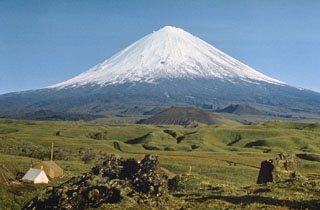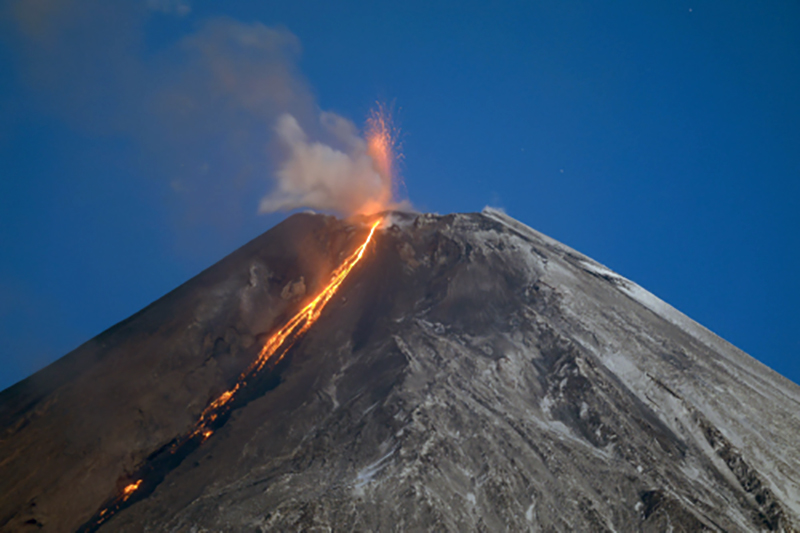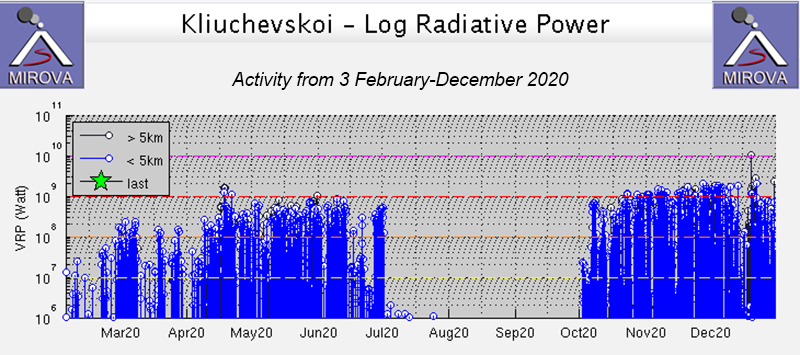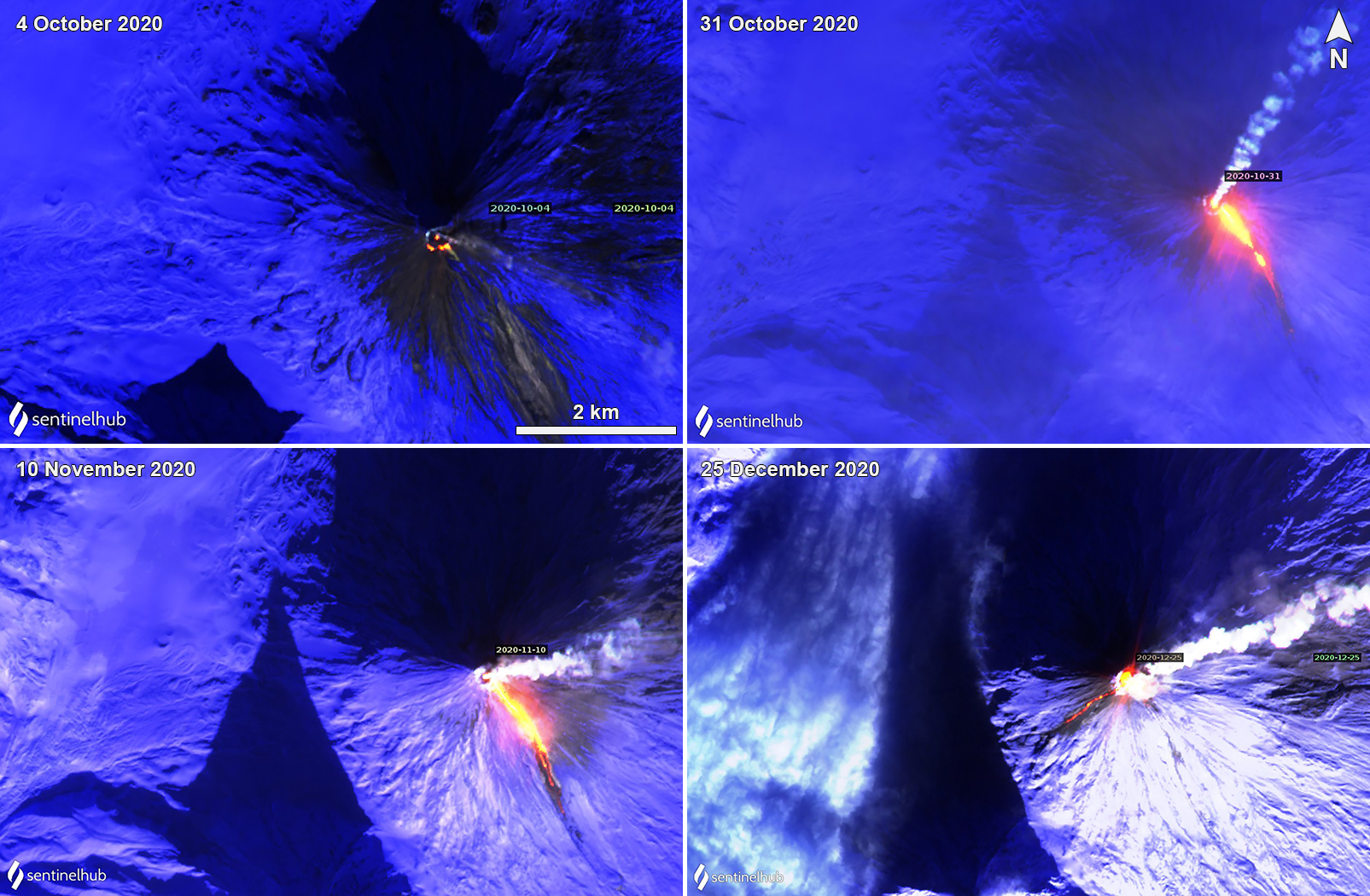Report on Klyuchevskoy (Russia) — January 2021
Bulletin of the Global Volcanism Network, vol. 46, no. 1 (January 2021)
Managing Editor: Edward Venzke.
Edited by Kadie L. Bennis.
Klyuchevskoy (Russia) Renewed activity in October 2020 with explosions, lava flows, and ash plumes
Please cite this report as:
Global Volcanism Program, 2021. Report on Klyuchevskoy (Russia) (Bennis, K.L., and Venzke, E., eds.). Bulletin of the Global Volcanism Network, 46:1. Smithsonian Institution. https://doi.org/10.5479/si.GVP.BGVN202101-300260
Klyuchevskoy
Russia
56.056°N, 160.642°E; summit elev. 4754 m
All times are local (unless otherwise noted)
Klyuchevskoy, located in northern Kamchatka, has had historical eruptions dating back 3,000 years characterized by major explosive and effusive eruptions from the flank craters. The current eruption began in April 2019 and has recently consisted of Strombolian activity, ash plumes, and an active lava flow descending the SE flank (BGVN 45:09). This report covers September-December 2020 and describes similar activity of Strombolian explosions, ash plumes, and active lava flows beginning in early October. Information primarily comes from weekly and daily reports from the Kamchatkan Volcanic Eruption Response Team (KVERT), the Tokyo Volcanic Ash Advisory (VAAC), and satellite data.
Activity from July through September was relatively low, with no thermal activity detected during August-September. On 2 October renewed Strombolian explosions began at 1003, ejecting ash 300-400 m above the summit and producing gas-and-steam plumes with some ash that drifted down the E flank (figure 48). That night, crater incandescence was visible. On 5 October KVERT reported that a lava flow began to effuse along the Apakhonchich chute at 0100. During 7-8 October activity intensified and was characterized by strong explosions, collapses of the sides of the drainage, strong thermal anomalies, and ash plumes that extended over 200 km SE from the crater; the lava flow remained active and continued to descend the SE flank. A Tokyo VAAC advisory issued on 7 October reported that an ash plume rose to 8.8 km altitude and drifted E and SE; during 8-9 October ash plumes rose to 5.5 km altitude and drifted as far as 270 km SE. A strong, bright, thermal anomaly was observed daily in satellite imagery, which represented the new lava flow. Strombolian explosions continued throughout the month, accompanied by gas-and-steam plumes containing some ash and an active lava flow advancing down the Apakhonchich chute on the SE flank (figure 49).
Similar activity continued to be reported in November, consisting of Strombolian explosions, ash plumes, and a lava flow advancing down the SE flank. A bright thermal anomaly was observed in thermal satellite imagery each day during the month. During 16-19 November explosions recorded in satellite and video data showed ash plumes rising to 7.5 km altitude and drifting as far as 108 km to the NE, E, SE, and S (figure 50). On 19 November an ash cloud 65 x 70 km in size drifted 50 km SE, according to a KVERT VONA (Volcano Observatory Notice for Aviation). During 26-30 November video and satellite data showed that gas-and-steam plumes containing some ash rose to 7 km altitude and extended as far as 300 km NW and E, accompanied by persistent moderate explosive-effusive activity (figure 51).
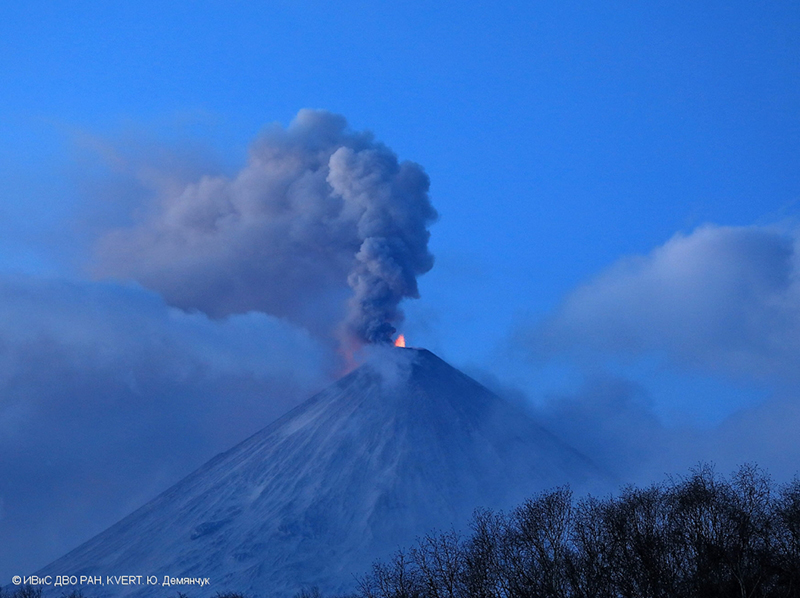 |
Figure 50. Photo of the Strombolian and Vulcanian explosions at Klyuchevskoy on 18 November 2020 which produced a dense gray ash plume. Photo by Yu. Demyanchuk, IVS FEB RAS, KVERT |
Moderate explosive-effusive activity continued through December; a strong daily thermal anomaly was visible in satellite images. During 2-3 December gas-and-steam plumes containing some ash rose to 7 km altitude and extended 300 km NW and E. Intermittent gas-and-ash plumes continued through the month. On 7 December KVERT reported that a new lava flow began to advance down the Kozyrevsky chute on the S flank, while the flow on the SE flank continued. Strombolian explosions in the crater ejected incandescent material up to 300 m above the crater on 8 December while hot material was deposited and traveled 350 m below the crater. A cinder cone was observed growing in the summit crater and measured 75 m tall.
Strombolian and Vulcanian activity continued during 11-25 December, accompanied by the lava flow on the S flank; according to Sentinel-2 thermal satellite images, the effusion on the SE flank had stopped around 13 December and had begun to cool. The lava flow in the Kozyrevsky chute spalled off incandescent material that continued to travel an additional 350 m. Gas-and-steam plumes that contained some ash rose to 6 km altitude and drifted up to 350 km generally E. On 24 December the Kamchatka Volcanological Station field team visited Klyuchevskoy to do work on the field stations. The scientists observed explosions that ejected incandescent material 300 m above the crater and the S-flank lava flow (figure 52). On 28 December KVERT reported that the moderate explosive-effusive eruption continued, but the intensity of the explosions had significantly decreased. The lava flow on the S flank continued to effuse, but its flow rate had already decreased.
MIROVA (Middle InfraRed Observation of Volcanic Activity) analysis of MODIS satellite data shows frequent and strong thermal activity beginning in early October and continuing through December 2020, which is represented by the active lava flows reported in the summit crater (figure 53). According to the MODVOLC thermal algorithm, a total of 615 thermal alerts were detected at or near the summit crater from 1 October to 31 December; none were reported in September. Sentinel-2 thermal satellite imagery frequently showed the progression of the active lava flows as a strong thermal anomaly descending the SE flank during October through late November and the SW flank during December, sometimes even through weather clouds (figure 54). The thermal anomalies were commonly accompanied by a gas-and-steam plume that drifted mainly E and NE. A total of 164 VAAC advisories were issued from 2 October through 31 December.
Geological Summary. Klyuchevskoy is the highest and most active volcano on the Kamchatka Peninsula. Since its origin about 6,000 years ago, this symmetrical, basaltic stratovolcano has produced frequent moderate-volume explosive and effusive eruptions without major periods of inactivity. It rises above a saddle NE of Kamen volcano and lies SE of the broad Ushkovsky massif. More than 100 flank eruptions have occurred during approximately the past 3,000 years, with most lateral craters and cones occurring along radial fissures between the unconfined NE-to-SE flanks of the conical volcano between 500 and 3,600 m elevation. Eruptions recorded since the late 17th century have resulted in frequent changes to the morphology of the 700-m-wide summit crater. These eruptions over the past 400 years have originated primarily from the summit crater, but have also included numerous major explosive and effusive eruptions from flank craters.
Information Contacts: Kamchatka Volcanic Eruptions Response Team (KVERT), Far Eastern Branch, Russian Academy of Sciences, 9 Piip Blvd., Petropavlovsk-Kamchatsky, 683006, Russia (URL: http://www.kscnet.ru/ivs/kvert/); Kamchatka Volcanological Station, Klyuchi, Kamchatka Krai, Russia (URL: http://volkstat.ru/); Tokyo Volcanic Ash Advisory Center (VAAC), 1-3-4 Otemachi, Chiyoda-ku, Tokyo 100-8122, Japan (URL: http://ds.data.jma.go.jp/svd/vaac/data/); MIROVA (Middle InfraRed Observation of Volcanic Activity), a collaborative project between the Universities of Turin and Florence (Italy) supported by the Centre for Volcanic Risk of the Italian Civil Protection Department (URL: http://www.mirovaweb.it/); Hawai'i Institute of Geophysics and Planetology (HIGP) - MODVOLC Thermal Alerts System, School of Ocean and Earth Science and Technology (SOEST), Univ. of Hawai'i, 2525 Correa Road, Honolulu, HI 96822, USA (URL: http://modis.higp.hawaii.edu/); Sentinel Hub Playground (URL: https://www.sentinel-hub.com/explore/sentinel-playground).

